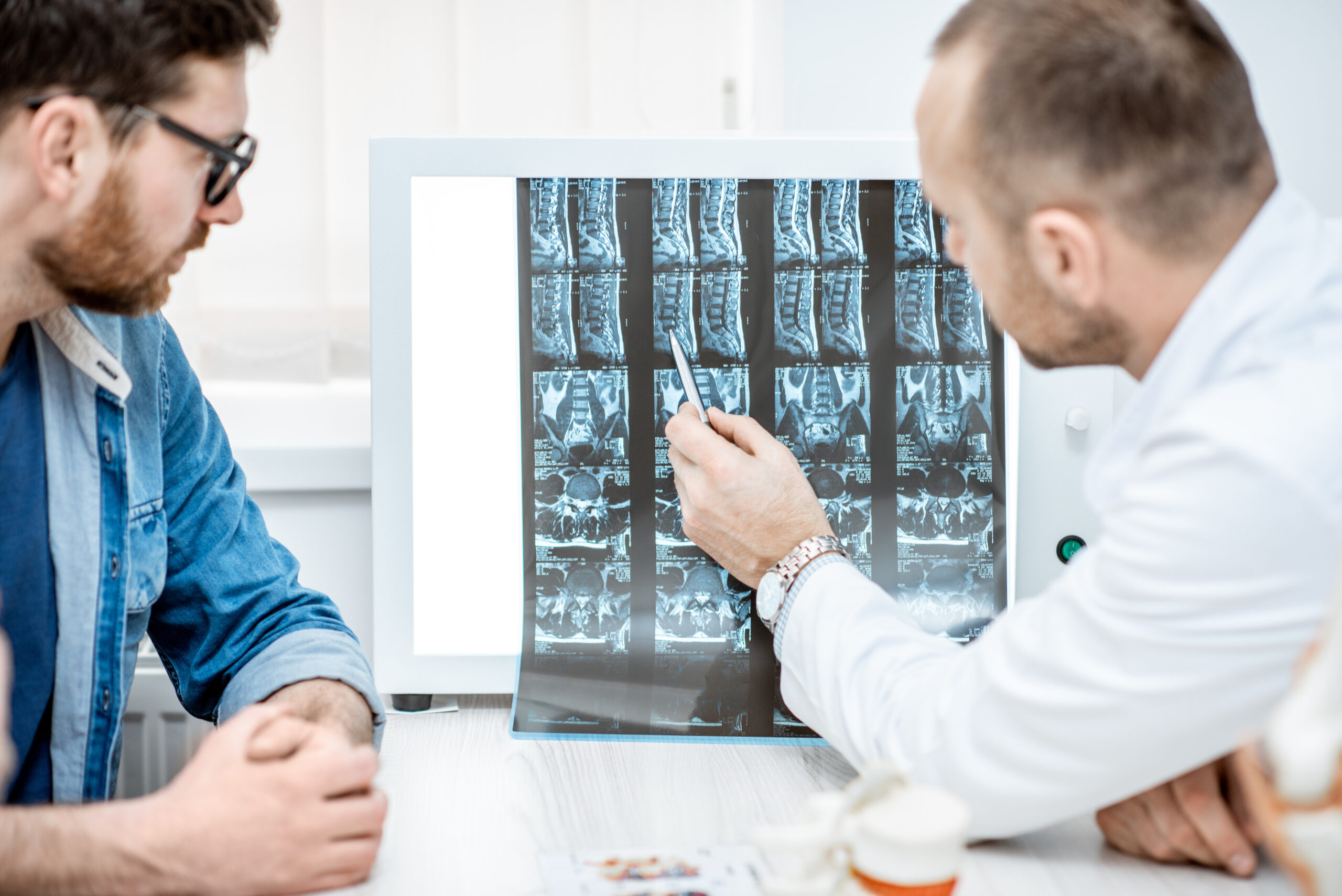
Spinal stenosis occurs when the space within the backbone becomes too narrow, preventing the nerves from effectively passing information to and from the brain. Patients who develop spinal stenosis may experience numbness and tingling where the narrowing occurs, along with muscle weakness or numbness in the extremities. For example, if the stenosis is in the lower back, numbness may be noticeable in the legs and feet.
Spinal stenosis can occur in young children and adults but can also develop as people age. While genetics are one factor that determines whether or not you are likely to experience spinal stenosis, it isn’t the only cause. Keep reading to learn more about this condition, how to prevent it, and how to seek treatment for uncomfortable symptoms.
Can Spinal Stenosis Be Passed Down Genetically?
Genetics plays a role in whether someone is likely to develop spinal stenosis. While this condition might not have a direct genetic line, it is common in several hereditary conditions. For example, someone who is prone to herniated discs might also be more likely to develop spinal stenosis. One condition leads to another. Other conditions that make people more prone to spinal stenosis include:
- Congenital kyphosis: when the spine curves out more than it should.
- Multiple exostoses: a condition that causes small bone growths along the vertebrae.
- Osteopetrosis: a rare condition where a child’s bones are abnormally dense.
- Spinal dysraphism is when the spine or spinal cord doesn’t develop properly.
While a patient who presents with these conditions might not immediately have spinal stenosis, they could develop this condition later in life. While spinal stenosis has diagnosable side effects and treatment options, it is often caused by preexisting issues.
Even if you don’t have a significant spinal condition, you may be more likely to develop stenosis as you age. You may have a naturally narrow spinal canal or will develop certain bone diseases (like osteoarthritis or rheumatoid arthritis) that wear down your joints. A patient may have spinal stenosis for years without any symptoms, but when symptoms start to appear they get worse.
Most people who develop spinal stenosis are over the age of 50. It is much more likely for young people diagnosed with this condition to have developed it as a result of other spinal diseases and hereditary problems.
The Role of Inflammation and Autoimmune Conditions
While a variety of spinal conditions can lead to the development of stenosis, there is one significant indicator that reflects the likelihood of developing this condition. A genetic predisposition to inflammation (or diseases that lead to inflammation as a side effect) can cause unwanted wear and tear on the body.
Chronic inflammation can accelerate spinal degeneration. When your body perceives a threat, it uses inflammation to protect the affected area. As a patient, you may notice that part of your body feels tender, painful, and swollen. Chronic inflammation occurs when your body continues to have a threat response even though it’s not in danger. Rheumatoid arthritis is a form of chronic inflammation. Other autoimmune diseases like ankylosing spondylitis may cause chronic inflammation that leads to spinal stenosis.
Inflammation can put pressure on your vertebrae and nerve canal, which can put undue stress on your spine even though your body is trying to heal itself. Once you treat the inflammation, you may notice lingering back pain because of accelerated wear on your spine.
Non-Genetic Causes of Spinal Stenosis
It’s possible to develop spinal stenosis even if you lack any predisposition to this disease. You may live most of your life with a healthy spin and then develop this condition as you age. In fact, aging-related degeneration is the most common cause of spinal stenosis.
Your spine changes as you get older. The protective discs between your vertebrae can wear out or break (a condition known as degenerative disc disease) and can shift into your nerve canal. Osteoarthritis, which is not hereditary, can wear out your joints and also affect the placement of your bones. If you are born with a naturally narrow spinal canal, these conditions can speed up the development of spinal stenosis or make the symptoms more noticeable early on.
Spinal stenosis is also found in people who experience back injuries. If you have a sports injury, are in a car crash, or have a nasty fall that hurts your spine, you may develop stenosis as a result of how your body heals. Similarly, patients who have had spinal surgery may develop stenosis as they age because of the changes to the vertebrae and spinal discs.
Just because you aren’t at a high risk for spinal stenosis doesn’t mean you can’t develop this condition. Your lifestyle might have a bigger impact on your future spinal health than you realize.
How to Reduce the Risk of Spinal Stenosis
It can be challenging to prevent spinal stenosis, especially if you are predisposed to other spinal conditions. However, you can still take steps to practice good spinal health and reduce your risk of developing this condition. You can also create these healthy habits even if you have no spinal problems or pain. Because natural wear and tear is one of the biggest causes of spinal stenosis, there’s never a bad time to embrace good back health. Here are a few things to try:
- Choose healthy foods: develop a balanced diet with plenty of vegetables and protein sources. This will help you get the vitamins and minerals you need.
- Discuss supplement options: talk to your doctor about adding supplements to your diet to support your spinal health.
- Exercise: Low-impact exercises can boost heart health while helping you build muscle. Consider options like swimming or cycling. Ask your doctor whether lifting weights is safe and recommended.
- Maintain a healthy weight: excess weight places pressure on the spine and can cause additional wear and tear.
- Practice proper posture: get in the habit of sitting up straight and standing tall when you walk. This promotes spinal alignment while also making you feel more confident.
- Stop smoking: both smoking and vaping cause significant damage to the human body. There’s never a bad time to quit.
If you are worried about developing spinal stenosis, early intervention is key. Schedule regular checkups with your doctor and ask them to assess your spine. Seek treatment immediately if you develop back pain that persists or has no known cause. This is particularly important if you notice other symptoms like numbness or tingling. The earlier you talk to a doctor and the more details you can provide about your symptoms, the sooner they can get a precise diagnosis.
Seek Treatment for Spinal Stenosis
While genetic predisposition can contribute to spinal stenosis, most cases are due to non-hereditary factors like aging and lifestyle. This is good news for patients at risk of stenosis or developing symptoms. You can change your lifestyle and seek medical treatment to reduce your discomfort.
Spinal stenosis symptoms tend to worsen if they are ignored. The earlier you meet with a medical professional, the sooner you can get the needed help. Proper spine care can reduce your risk of developing this condition, but early medical intervention can also help you out.
If you experience any back pain or spinal discomfort, contact Dr. Todd H. Lanman at the Advanced Disc Replacement Spinal Restoration Center. Dr. Lanman is a leading spinal neurosurgeon with over 30 years of experience helping patients alleviate and manage back pain. He believes in personalized treatment plans and long-term solutions that support spinal health. Request a consultation with Dr. Lanman today or find a trusted neurosurgeon in your area through the Top Doctors Directory. Your stenosis may be treatable with the help of these medical experts.
FAQs
Can spinal stenosis be passed down genetically?
While spinal stenosis itself isn’t genetic, other conditions that affect the spine are. If you are genetically predisposed to developing spinal problems, then you are at a higher risk of spinal stenosis. This condition is also found in patients without any hereditary spinal problems.
What are the most common causes of spinal stenosis?
Spinal stenosis is often caused by hereditary conditions that affect the backbone. However, it is also found in people who have natural wear and tear on their spines. Poor spinal hygiene, accidents that affect your spine, and recovery from surgery can all trigger stenosis. Your lifestyle can also affect whether you develop spinal stenosis and what treatment options are available to you.
Can lifestyle changes reduce the risk of spinal stenosis?
Lifestyle changes cannot eliminate your risk of spinal stenosis, but they can support your spinal health and reduce your risk of developing worse symptoms. Taking steps to maintain good posture, eat well, and exercise can all improve the condition of your spine. Your doctor may recommend additional medical interventions to treat your stenosis if it starts to interfere with day-to-day life.
Ready to reclaim your life? Get in touch with Dr. Lanman Today.
FOLLOW US ON SOCIAL MEDIA | @ADRSPINE





